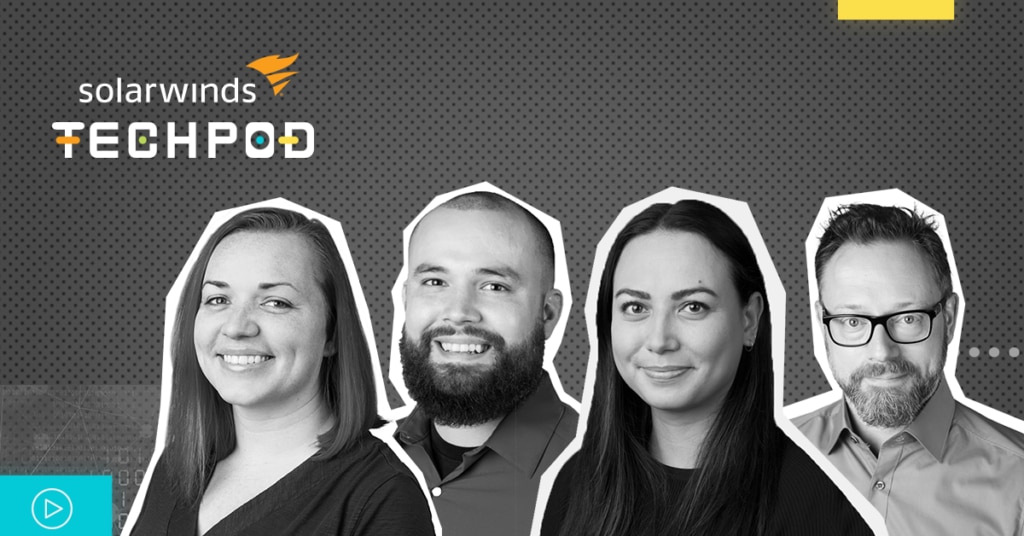Our second SolarWinds Day was another success!
For our second SolarWinds Day, we focused on our customers. We shared exciting new product updates, new tool releases, and some helpful tips for navigating 2023. Let’s dive into our recap, and make sure to check out the end of the post for a quick FAQ of questions asked by those in attendance.
First of all, if you missed the event or want to revisit any sections, you can watch the full event on-demand here:
Our event began with an introduction from Nik Koutsoukos, vice president of marketing at SolarWinds. He introduced our focus for this event: the opportunities ahead of us and how the SolarWinds® Platform can simplify complex IT environments through observability, helping customers consolidate tools so they can gain a single source of truth, increase productivity, and reduce costs.
Tips to drive modernization
Koutsoukos spoke with Stephen Elliot, IDC group vice president of I&O, cloud operations, and DevOps. Elliot discussed business priorities, focusing on tool consolidation and simplification. He related tool consolidation to car insurance, stating, “Everyone has it but has varying levels of it.” Determining the right amount for your organization is the trick.
As for organizations trying to simplify multiple clouds, Elliot said they must first accept the increasing complexity. Then, they must find solutions with multi-cloud support and try to simplify complexity as much as possible through dashboards, unified views, and organization. He pointed out observability solutions provide many ways to simplify complexity but warned every cost an organization tries to cut will carry risk to people, processes, and technology. He suggested IT leaders consider the right level of observability the business is willing to pay for. By developing key performance indicators (KPIs) and goals—which relate directly to customer satisfaction—Elliot said IT leaders can prepare an argument for budget. The overarching questions is, “What are you willing to risk to save money?”
For more of Elliot’s tips for business, you can watch the recording of the SolarWinds Day event.
New observability product features and updates
Next, Product Marketing Director Abigail Norman and I provided an overview of key product updates since our last SolarWinds Day in October. SolarWinds offers two observability solutions built on the SolarWinds Platform, and both are designed to meet customers where they are and help them smoothly navigate what’s next.
SolarWinds SolarWinds Observability Self-Hosted (formerly known as Hybrid Cloud Observability) is our self-hosted observability solution and is designed to unlock observability for hybrid IT environments and be an on-ramp to the cloud for customers with cloud migration plans. SolarWinds Observability SaaS (formerly known as SolarWinds Observability) is our cloud-native software as a service (SaaS) offering and is designed to simplify managing the health and performance of modern, custom applications, enabling DevOps teams to spend less time on firefighting and more time developing and deploying new applications to fuel innovation.
In addition, we reiterated the SolarWinds Platform is built with AIOps service and with our Secure by Design foundation in mind—every release has products and updates to help make it more secure. This is all available with simplified licensing, simplified deployment flexibility, and easy customization, making it easy to move into our observability solutions.
SolarWinds Observability Self-Hosted (formerly known as Hybrid Cloud Observability)
Accelerating root cause identification and remediation
AlertStack for SolarWinds Observability Self-Hosted (formerly known as Hybrid Cloud Observability) is now generally available to all customers who update to the latest release. AlertStack correlates alerts, events, and other problems on monitored entities, stacking them into a single view so customers can quickly identify the root cause of issues and resolve them. This helps them improve productivity and focus on what matters. AlertStack enhances our alert noise reduction capabilities, building on the AIOps-powered anomaly-based alerts announced with the release of SolarWinds Observability Self-Hosted (formerly known as Hybrid Cloud Observability) 2022.4 and helping to improve mean time to resolution.
Simplifying cloud observability
As environments become more hybrid and complex, we strive to deliver greater visibility and control with more simplicity across the entire IT ecosystem. We’ve streamlined and enhanced our cloud discovery process to bring customers additional granularity so they can choose what they want to observe as they onboard cloud objects to SolarWinds Observability Self-Hosted (formerly known as Hybrid Cloud Observability). We’ve also added the ability to import tags, find things across global cloud service regions, and more.
SolarWinds Observability SaaS (formerly known as SolarWinds Observability)
Top-to-bottom observability
In SolarWinds Observability SaaS (formerly known as SolarWinds Observability), the dashboard views allow you to see high-level performance metrics and drill down to the performance metrics of the dependent services and applications—all the way down to the code.
Expanding customer options
Global implementation—customer flexibility
- Hyperscaler: AWS or Azure
- Data centers: North America, Europe, or Asia-Pacific
Marketplaces
- Selling SolarWinds Observability SaaS (formerly known as SolarWinds Observability) directly through hyperscalers
- AWS Marketplace—live
- Azure Marketplace—Q1 2023
Co-selling partnerships
- Microsoft—Gold ISV Partner
- Amazon—AWS ISV Accelerate Program
Out-of-the-box integrations
- AWS CloudWatch
- Azure Monitor
You can see a side-by-side comparison of SolarWinds Observability Self-Hosted (formerly known as Hybrid Cloud Observability) and SolarWinds Observability here.
Customer unlocks end-to-end visibility
Finally, we heard from a current SolarWinds Observability Self-Hosted (formerly known as Hybrid Cloud Observability) customer, Jeppie Sumpter, assistant vice president for IT services at Western Kentucky University, and Jeff Stewart, field CTO at SolarWinds. As a longtime SolarWinds customer who was looking for an observability solution to support their growing and distributed campuses, Sumpter knew SolarWinds would provide a simplified solution.
About using SolarWinds solutions, Sumpter said, “I don’t think we can imagine an environment without these tools. SolarWinds has been our partner on this road for over 15 years.” He continued, saying, “If we were trying to do today with bits and pieces what we are doing with SolarWinds, I can’t imagine what labor resources it would take to do that. And by no means would you have that cohesive view of everything, which is where the real power comes into play. The tools, the features that they have now as we’re getting into AI and baselining concepts and anomaly detection, it’s far beyond just ‘this thing is broken, figure it out’ and more a focus on what is not performing well. And we have a tremendous amount of assistance with the tool to figure out where that is happening because it looks deep and it looks wide and gives us that end-to-end view.”
You can read more about how SolarWinds Observability Self-Hosted (formerly known as Hybrid Cloud Observability) allows Western Kentucky University to gain fuller visibility across its on-premises and hybrid environments in this case study.
Helping our customers today and in the future
To take us home, THWACK® community managers Robert Blair Vega and Kristen Piña Flores provided an overview of our phenomenal community (190,000 strong) and talked through what’s in store for 2023. Not a member yet? Check it out here.
Quick FAQs
- Are there any plans to offer SolarWinds Observability SaaS (formerly known as SolarWinds Observability) for Google Cloud Platform (GCP)?
Yes, SolarWinds Observability SaaS (formerly known as SolarWinds Observability) can observe applications running on GCP. In the future, we intend to continue to build out tight integrations to make it easier to consume GCP services.
- Which security products does SolarWinds Observability Self-Hosted (formerly known as Hybrid Cloud Observability) integrate with to deliver Security Observability?
Security Observability is delivered through Security Event Manager (SEM), Access Rights Manager (ARM), and Patch Manager.
- Can you use SolarWinds Observability Self-Hosted (formerly known as Hybrid Cloud Observability) even in a fully offline environment?
Absolutely. We support completely offline deployments, and SolarWinds Observability Self-Hosted (formerly known as Hybrid Cloud Observability) can run in an air-gapped environment. AIOps capabilities such as AlertStack that don’t require machine learning are fully accessible to offline environments. However, any AIOps capabilities using our machine learning engine (such as anomaly-based alerts) do require a connection to the cloud.




